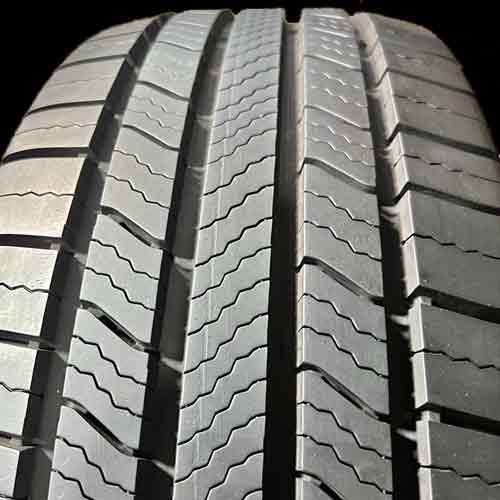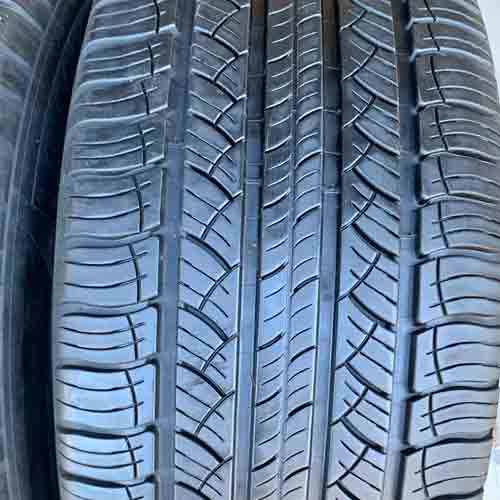With the Latitude Tour HP, Michelin targets the upscale SUV market, ensuring smooth rides and handling. On the flip side, the Defender 2 coming in the standard touring category, broadens its reach, emphasizing durability and consistent year-round traction. Let’s see which of these tires better suit your needs.

So as a tire engineer, taking a closer look at these tires revealed to me that the Michelin Latitude Tour HP comes with a superior dry handling and stopping power, and steering (responsiveness), in all conditions. Moreover it also offers advanced winter performance with better ice and snow traction. Conversely, the Defender 2 offers a quieter ride, a longer tread life, and improved fuel economy due to its lower rolling resistance.
Table of Contents
Tread Design
While both tires share the brand name, there are some main points to note about them both, structure wise, I mean.

Let’s start off with Michelin Defender 2’s design first.
- At a glance: The Defender 2 presents a more streamlined symmetric design with a total of five ribs.
- Outer Ribs: The exterior 2 shoulder ribs are rather straightforward, where block exhibits a single wave-like siping slit.
- Central Most Rib: The middle most rib is continuous-running and is adorned with a lot more interlocking sipes, which are also slightly angled.
- Adjacent ribs: Neighboring to the middle, are ribs with less siping (of different angles). They also carry in-groove notches as well, interconnecting longitudinal grooves.
- Inner construction: Within, the tire has a durable build. It’s fortified with a single layer of polyester for its casing, paired with two steel belts, and finally capped with nylon.
Moving towards, the Michelin Latitude Tour HP…

- Design: This tire also follows a symmetric tread pattern with five ribs. Though all its ribs have stronger reinforced foundations, comparatively.
- Central-Most Rib: The central rib of this tire is continuously running. Its design emphasizes the formation of robust circumferential grooves, facilitated by the rib’s offset edges.
- Adjacent Ribs: Surrounding the centerpiece rib, the adjacent ones possess interlinked in-groove notches. These notches further connect to the outer longitudinal channels.
- Shoulder Ribs: Compared to the central ribs, the shoulders are more streamlined, as they carry the least amount of biters on them. Though they still have a combination of longitudinal and lateral slits.
- Internal Construction: Inside, the tire is similarly built with a single polyester ply for its casing, reinforced with two steel belts, and topped off with, again a single, nylon cap ply.
Size Options
Given the unique requirements of each tire for distinct vehicles, the subsequent table provides a clear comparison to facilitate your choice.
| Specs | Defender 2 | Latitude Tour HP |
|---|---|---|
| Rim Size (inches) | 16 to 20 | 16 to 22 |
| Speed Ratings | H | H, V, W, Y |
| Load Ratings | SL, XL | SL, XL |
| Tread Depth (32″) | 10.5 | 9 to 10 |
| Weight Range (lbs) | 25 to 32 | 27 to 43 |
| Winter Ratings | M+S | N/A |
| Mileage Warranty | 85k miles | 55k (H/V) or 45k (W/Y) |
| UTQG Rating | 800 A A | 440 A B |
- Review the Latitude Tour HP variant, in greater details: https://tiredriver.com/michelin-latitude-tour-hp-review/
- Review Defender 2 in greater details: https://tiredriver.com/michelin-defender-2-review/
Wet Traction
The overall wet performance depends on tire’s ability to clear water form it’s tread/or road beneath it’s rubber, so that it’s biters can make proper contact with the relatively dried up surface.
Now, this is already a pretty weak point for Defender 2, I mean even when you compare it with other standard touring tires, so it makes sense why its counterpart is leading here as well.
Now, the Michelin Tour HP outshines with its exceptional handling and precision steering here. And this is largely attributed to its strategic siping pattern and the composition of its rubber material, which work together to enhance its performance.
I mean it comes with a more aggressive tread design, clearly (check it’s tread pattern again, by scrolling to the “construction” section).
As you may have noticed, its characterized by a comprehensive system of linked circumferential channels. These channels effectively channel water away from the footprint of the tire, improving its ability to resist hydroplaning.
And since more water going out, lessens the burden on the sipes, the overall wet traction is enhanced with that as well.
Though it’s numerous angled siping don’t need any help.
Side Note: If you’re wondering how sipes work, just think of them as water containers. Since water has to go somewhere, when it gets the pressure/weight of the tire, it squeezes into those slits, which later spray water particles out.
So yes, in summary, the Michelin Latitude HP not only provides outstanding traction, particularly in maneuverability, but also demonstrates enhanced resistance to hydroplaning when compared to the Defender 2.
Noise Dampening Ability
When it comes to the road “quietness”, the Michelin Defender 2 takes the lead.
At lower speeds, the tire only produces a faint white noise, while on highways, its a bit more noticeable, it still tends to merge seamlessly into the ambient noise.
There is also a specific interaction of sounds between the tire tread and the road surface, particularly noticeable when taking on and off ramps.
But yes, overall sound profile of this tire, as seen by it’s decibel readings is on the quieter side.
Whereas on the Michelin Latitude Tour, you get a more pronounced auditory presence where it’s greater in-groove resonance, and some cavity sounds contribute.
Moreover, with a lot more biting edges, the tire also emits growling sounds.
Dry Performance
Assessing a tire’s dry performance involves weighing two pivotal aspects:
- Tire’s directional grip.
- Overall handling.
Let’s talk both.
Directional Grip
Directional grip/traction is shaped by various factors, such as the tread compound, the extent of contact between the tire and the road, as well as the tire’s weight. And yes, this traction is primarily evaluated through the tire’s ability to stop efficiently when braking.
In this regard, the Michelin Latitude Tour HP stands out, which is not a surprise, since it’s a HP (high performance) tire here, where it comes with a rubber composition, tailored to provide superior grip on dry surfaces.
That’s why if offers speed ratings up to Y, whereas the Defender 2 (which is a mere standard touring tire), only comes with H (on all its sizes).
Although the Michelin Defender comes with a lighter construction, which creates less overall momentum (when the tire is moving at high speeds), it still trails behind, with its missing biters.
I mean sure, it features multiple siping, and it’s central two ribs (neighbor to shoulders), have in-groove notches, but that’s nothing compared to the interlocking biters seen on Latitude Tour.
So yes, we have a clear winner here.
Dry Handling
The Michelin Latitude Tour HP dominates in the realm of dry handling, as it offer both better lateral grip and steering accuracy.
Both these components together actually define the overall grip.
Now, sure, the Defender 2 also offers appreciable lateral grip/traction, (as suggested by it’s comparable lateral g-force readings), the Latitude Tour HP still takes a notable lead, with it’s more stable steering responsiveness.
And that’s all thanks to it’s spirally-wound nylon cords, and and multi-directional in-groove notches on it’s shoulders.
(Shoulders make the most contact, while the tire is turning).
Tread Life
Discussing tread life, one can clearly see, why the Michelin Latitude Tour HP is the one lacking behind, signifcantly, despite it’s robust silica-based tread compound.
And this difference is evident in their respective UTQG ratings.
I mean sure, the UTQG is not the most reliable for cross-brand comparisons, as I explained here, it becomes a very valuable metric within the same brand.
Meaning, the Michelin Defender 2’s treadwear rating of 800 indicates that it can last up to eight times longer than the reference tire, whereas its counterpart, with a rating of 440, suggests a lifespan of only four times that of the reference tire.
So you can say that the Defender 2 can easily last twice as long as the Latitude Tour HP, where the tire’s light weight structure, combined with fewer notches, results in lower rolling resistance generation.
Moreover, the Defender also offers a deeper tread, allowing for a longer duration before reaching the minimum legal tread depth of 2/32 inches in the United States.
Winter Traction
A comprehensive review of a tire’s winter performance must take into account essential aspects, such as grip, handling, and versatility on various snowy surfaces (predominately ice, and snow).
In this category, the Michelin Latitude Tour HP emerges as the superior choice, where it’s intricate siping and the inclusion of snow-biting ribs equipped with snow vices significantly enhance traction on both, icy and snowy terrains.
Moreover, as the Latitude Tour HP’s rubber is relatively softer, the sipes on it maintain the needed flexibility even in sub-zero temperatures, benefiting from their multi-directional layout that ensures a superior grip on icy surfaces.
And if I talk about (soft/powdery) snowy tracks, it’s numerous grooves and notches designed to capture and compact snow provide and promote a more effective snow-to-snow contact, which naturally creates more friction due to the tendency of snow particles to adhere to one another.
Fuel Economy
Fuel efficiency is influenced by a variety of factors, notably the tire’s tread compound and its overall heft/construction weight.
In this respect, the Michelin Defender 2 stands out clearly, exhibiting reduced rolling resistance when compared to its counterpart.
So why is that?
Well simply put, the tire with a lighter build and less aggressive tread design generates less rolling resistance against the road.
Whereas the Latitude Tour does the opposite. But this is the cost you have to pay (literally, in terms of fuel), in return for the impressive grip this tire brings along.
I mean it makes sense that the tire maxes out when it comes to speed rating, and that of course is a disadvantage regarding fuel economy, since speed rating is directly proportional to the tire’s rolling resistance.
In Closing
Each tire offers unique benefits, thus your choice hinges on personal taste and the specific driving conditions you face.
The Michelin Latitude Tour HP excels in the following:
- Superior overall dry performance.
- Better handling and steering accuracy, in both dry and wet conditions.
- Outstanding winter performance with advanced traction on icy and snowy surfaces.
While the Michelin Defender 2 takes the lead in:
- Quieter ridem with excellent noise dampening abilities.
- Significantly longer tread lifem with it’s more streamlined ribs.
- Enhanced fuel economym due to lower rolling resistance.
I’m currently riding on Latitudes that came on our Lexus RX350.
They’ve been ok for the first 30k but now are untrustworthy in newly wetted roads and at upper highway speeds (some drifting). Road noise has greatly increased as well as worse fuel mileage(!!).
They’ve never been good on ice but satisfactory in even wet snow.
We are very cautious drivers in this vehicle and now rarely venture out when it’s icy and snowy.
Thinking about moving on to Defender 2.
Switching to the Michelin Defender 2 is a good choice if you want tread life and fuel economy, whereas Latitude offers better wet and winter traction.
There’s some confusion here: you said in your comparison review that the Latitudes are superior than D2 for driving in both wet and icy conditions
Sorry for the confusion, yes Latitude has better wet and winter performance, thanks for pointing it out, I’ll fix my comment now.